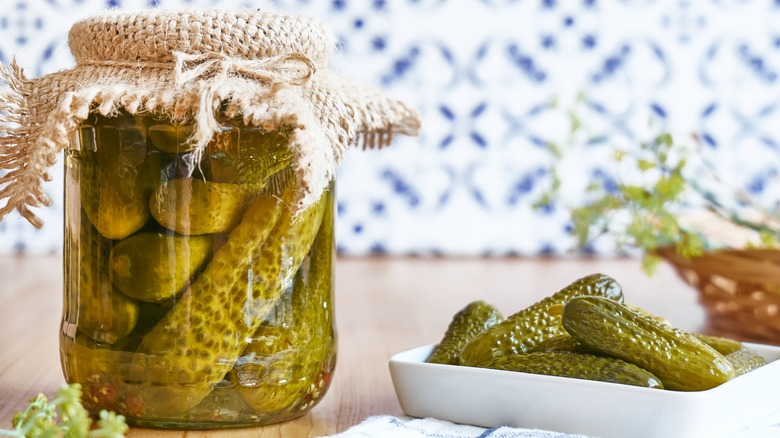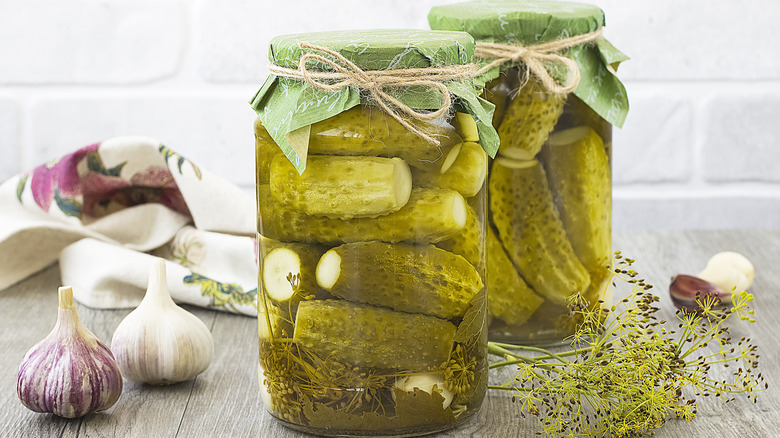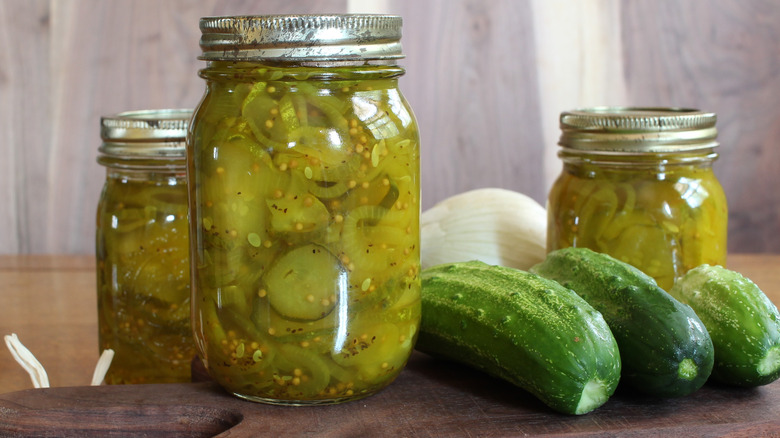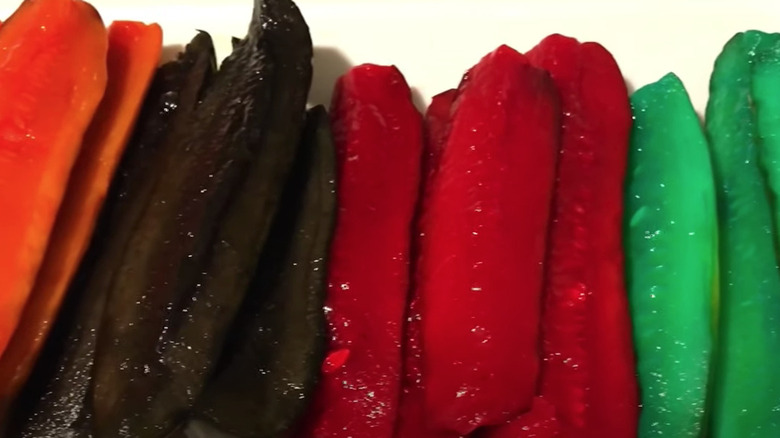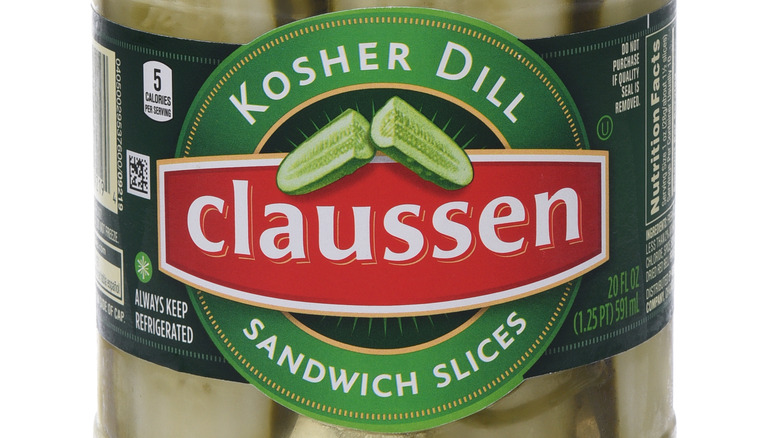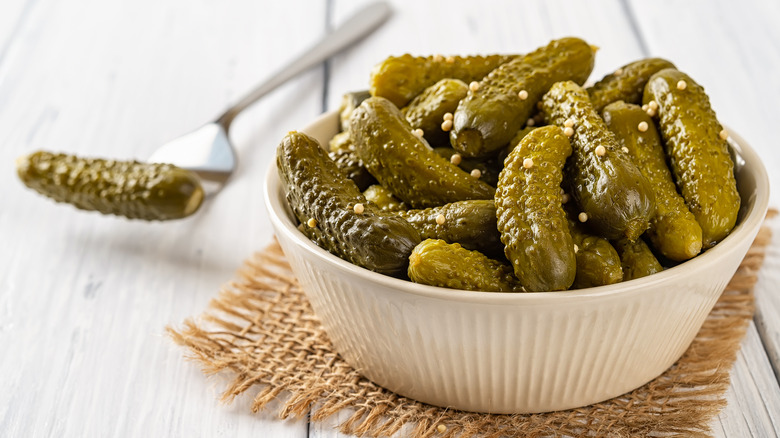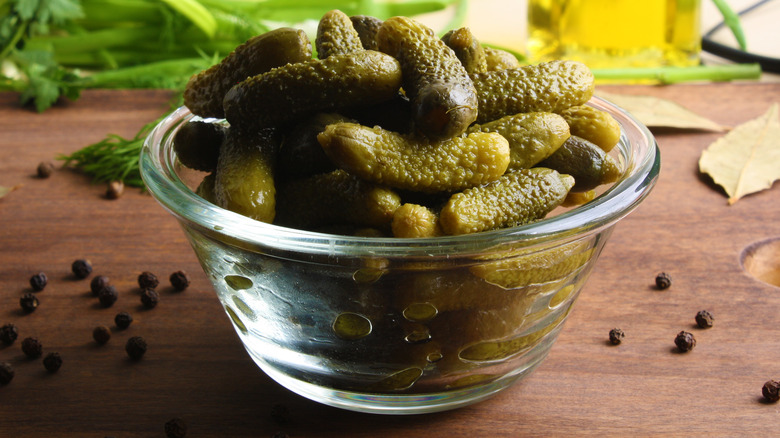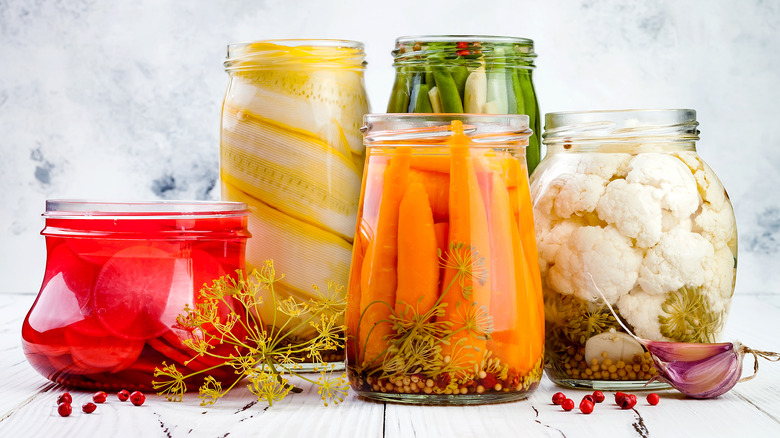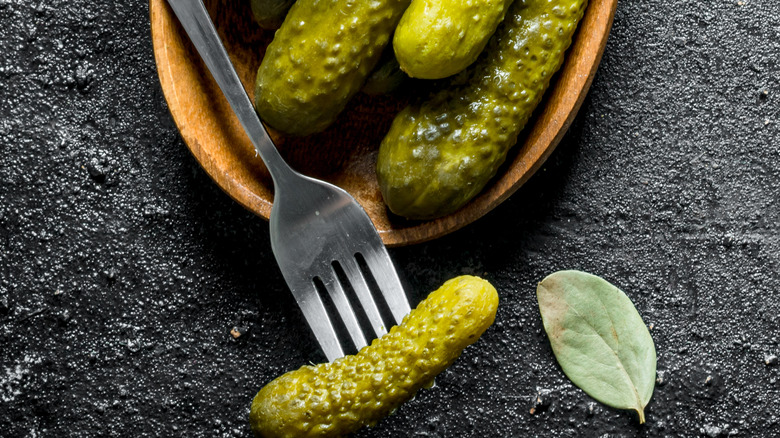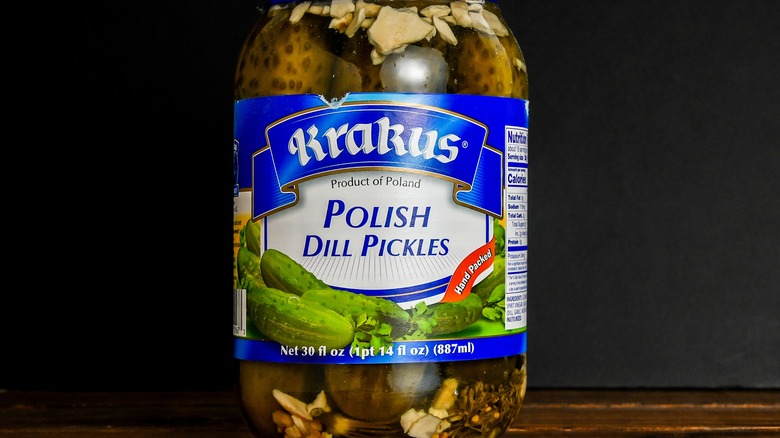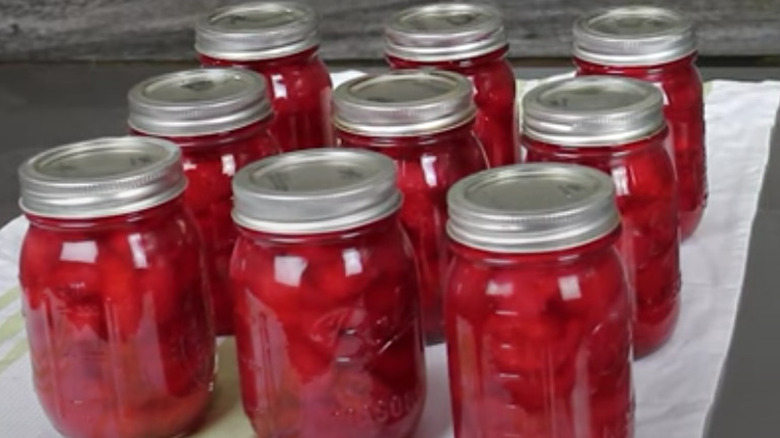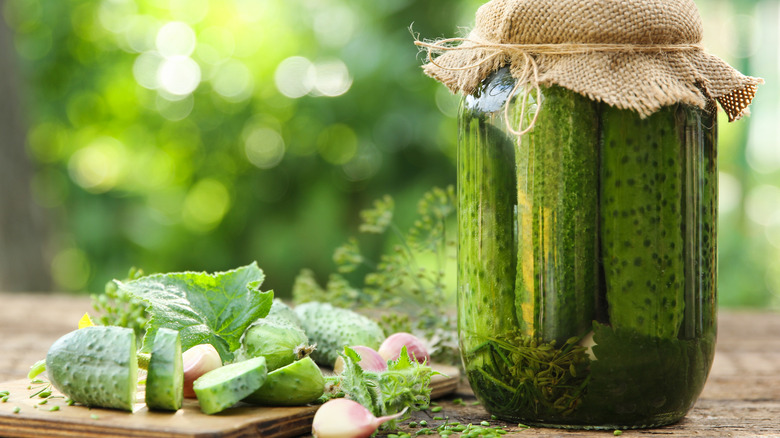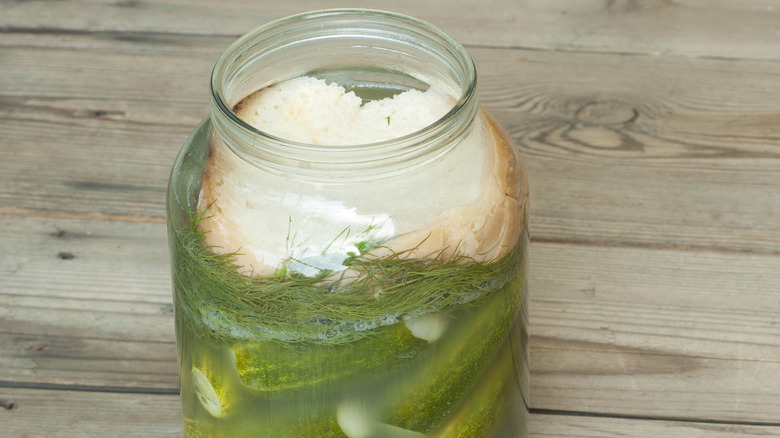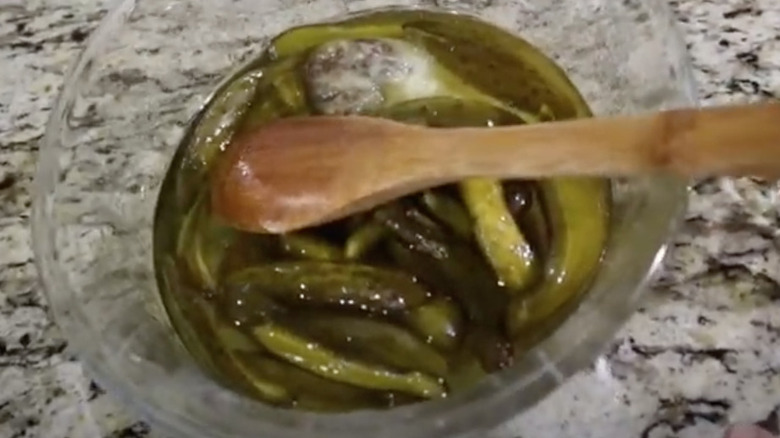13 Types Of Pickles Perfect For Snacking
We may receive a commission on purchases made from links.
Pickles have been popular throughout recorded history, which makes sense considering that in the days before refrigeration, people needed ways to preserve and store food that didn't involve electricity. In the case of fresh produce, they discovered that pickling, or covering fruits and vegetables in a brine of salt mixed with spices, plus water or vinegar, did the job nicely. Pickled produce allowed people to store harvested food for months, giving them nutrition during the off-season (via PBS).
Today, pickles are found wherever groceries are sold. Although we don't need them for survival anymore, they're a popular addition to sandwiches, burgers, salads, or dressings, and are even eaten straight from the jar. Pickles combine tanginess with crunchy, salty goodness, and are unlike anything else. In the United States, pickles are understood to be pickled cucumbers, even though other fruits and vegetables are pickled. When you consider that Americans eat around 20 billion pickled cukes every year, you can see why that happened.
While every pickle lover has a favorite, there are so many pickles to try that keeping an open mind might let you discover a new pickle for your plate.
Dill pickles
One of the most beloved pickle varieties, the dill pickle gets its name from the seeds and fronds of dill, the star flavoring of these crunchy pickles. Brands and recipes vary; many dill pickles include garlic, mustard seeds, salt, and coriander seeds. When choosing pickles stored at room temperature, the brine will be vinegar-based. Still, if you're buying refrigerated pickles from a deli or farmers' market, you're likely getting fermented pickles in salt brine (via Allrecipes).
Dill pickles are sold whole or as spears, chips, or halves, varying in color from a nearly fluorescent green (from added coloring) to a more natural olive tone. Different brands might offer a more garlicky pickle, one spicy from crushed red pepper, or a crisper one. According to Preserve & Pickle, pickles made using overripe cucumbers, processed with too much heat, or without enough salt in their brine won't have the crunch most people look for. Whether you make pickles in your kitchen or are shopping for a favorite brand, you'll find a dill pickle to love.
Bread and butter pickles
While many of us love pickles for their sharp, vinegary tang, sweet pickles are also delicious. Their salty, sharp kick is balanced with sugar, and gives a flavor we're hardwired to crave. Salt is meant to bring out the flavor in food, and pairing salty and sweet boosts the sweetness while creating a balance between tastes that people find irresistible (via How Stuff Works).
Bread and butter pickles are made by slicing pickling cucumbers and letting them sit salted before brining. Unlike salad cucumbers, pickling cucumbers are firmer, with sweet skins and undeveloped seeds that make perfect pickles. Using salt on the cucumber slices draws extra moisture to ensure crunchy pickles.
The brine is a mixture of sugar, vinegar, and spices like mustard seed, celery seed, garlic, chili flakes, ginger, and curry powder. The brine is boiled and poured over the cucumber slices, then packed into jars. Slices of onion are often added to homemade bread and butter pickles, but store-bought brands usually don't include them.
Making pickles at home is easy and fun, but make sure to always follow food safety guidelines. Refrigerator pickles should always be made in small batches and eaten promptly. The good news is that you can play around with spices and flavorings for bread and butter pickles to suit your tastes and how you plan to use them.
Kool-Aid pickles
If you've spent time in Mississippi or regularly scrolling TikTok, you may have heard of Kool-Aid pickles. Does it sound wacky? Sure, but turning pickles into something unexpected is fun, and adding a fruity, sweet-and-sour kick to them is even better. Kids and grownups love the bright colors, and matching pickles to a party theme would be absolutely epic!
You'll need to make Koolickles in your kitchen because although people have enjoyed them for decades, they aren't sold in stores. We think that adds to the fun, though. Take your favorite brand of pickles and pour the juice from the jar into a bowl, leaving the pickles behind for now. Then dump in a packet of your favorite Kool-Aid flavor (cherry seems to be the most popular, but you do you) and stir until the powder dissolves.
Some recipes add sugar and some don't. It's up to the level of sweetness you want. If you use sugar, try adding a spoonful at a time, stirring and tasting it till it's perfect. Then, pour the concoction back over the pickles in the original jar, close it tightly, and shake to combine. Leave the jar in the refrigerator for at least 24 hours (or up to a week if you're patient), and then see what magic you've created. Whether you want cherry pickles or mix it up and use another flavor like grape, orange, or blue raspberry lemonade, Kool-Aid pickles are sure to brighten your day.
Kosher dill pickles
There's often some confusion between kosher dill pickles and regular old dill pickles. Both are made with cucumbers and flavored with dill, so what's the difference? If you've figured it has to do with Jewish dietary laws, you're on the right track. But according to Chabad, in the case of kosher dill pickles, it's all about the pickling process, not having a rabbi present at the pickle factory.
Kosher dills are called kosher dills because they are made the way Jewish delis in New York City (which traditionally did have a rabbi oversee the pickle-making) made them. Kosher dills are fermented in a brine of water and Kosher salt flavored with garlic and dill. Regular dills may or may not have garlic; kosher dills do.
Jewish immigrants introduced kosher dill pickles to New York over a century ago, where they were sold on carts in the street. People couldn't get enough of them, and eventually, they were mass-produced. Traditional kosher dills were fermented in salt brine instead of vinegar, because vinegar could be made from Kosher wine. Using a kosher salt-and-water brine to ferment the pickles took questions about vinegar out of the equation. Today, kosher-style dills are sold everywhere, but only jars labeled "Kosher certified" are kosher according to Jewish dietary law.
Gherkins
Gherkins are adorably tiny — only two to three inches long — with knobby skin. They're often confused with sweet pickles because gherkins are often pickled with sugar, but gherkin refers to the type of cucumber, not the pickling process. Gherkins are super crisp and belong to the gourd family Cucurbitaceae, like other cucumbers. To make it more confusing, Mexican sour gherkins belong to the Cucurbitaceae family, but are not cucumbers. Also known as mouse melons or cucamelons, they look like tiny watermelons, and can be pickled. Still, the gherkin pickles commonly found in stores are their own cultivar of the cucumber family.
Sweet gherkins are the most common, but garlic, mustard seed, peppercorns, rosemary, and tarragon are some of the spices you can find added to pickled gherkins. It's the texture of a gherkin that's more important. They make a perfect snack, and are usually eaten whole to focus on crunchiness. Whether you eat them right from the jar, serve them alongside a meal, or enjoy them with a Bloody Mary, gherkins are popular with pickle lovers everywhere.
Cornichons
Cornichons are smaller than gherkins and less likely to be pickled with sugar. Their name translated from French means "little horn," which suits these bite-sized curved pickles to a tee. They came to Europe from India, and the French adopted them quickly, eventually cultivating new varieties like the Parisienne Cornichon de Bourbonne. They are eaten pickled and fresh and might be found in salads, alongside sandwiches, on charcuterie boards, or even blended into sauces.
Other countries often use the term gherkin and cornichon interchangeably, but eating them side by side reveals that cornichons are crunchier and are usually more savory than sweet. In France, cornichons may be made with white wine vinegar, peppercorns, tarragon, and chili pepper. Tarragon is widely used in France and has a slight licorice flavor that is sometimes also likened to mint or described as citrusy. Although there are Russian and Mexican tarragon varieties, French tarragon is most often used in the kitchen. No matter what you call them, these petite little pickles will quickly become a favorite.
Refrigerator pickles
Refrigerator pickles are simple, made by brining cucumbers and letting the jar sit refrigerated for at least one day. Refrigerator pickles let you get creative or use up a bumper crop from the garden. These pickles are made to be devoured, not stored in the pantry; shelf storage requires following safety guidelines to avoid serious illness.
Refrigerator pickles are easy to prepare, but you should let them sit salted overnight for crunchier pickles. Kosher salt or table salt without iodine or anti-caking additives will work, but pickling salt will keep the brine clear and the pickles from changing color (via The Kitchn). The storage jars should be washed with hot water, soap, and air dried before filling.
The brine for refrigerator pickles is commonly vinegar (apple cider or distilled white vinegar are most popular), salt, water, a bit of sugar, garlic, and fresh herbs and spices. You can make your pickles sweet, spicy, or anything in between, and you can add slices of onion or jalapeños to the jar to fancy up burgers or sandwiches.
Bring the brine ingredients to a boil to sterilize it (add fresh herbs and spices directly to the clean jars along with them), and then pour the brine over the vegetables till submerged. Let the jars cool down before refrigerating, then leave them alone to soak up all the flavors. They're totally worth the wait.
Sweet pickles
Sweet pickles are small, crunchy, and pickled by adding sugar to the brine. They're easy to find anywhere pickles are sold, but are also simple to make at home. They're similar to bread and butter pickles, but bread and butter pickles are packed in a thicker, more syrupy brine (via Old World Garden Farms).
Sweet pickles are made from smaller, younger pickling cucumbers than larger dill and sour pickle varieties, so they have small seed cores and stay crisp. You can buy them (or make them) like chips, spears, or whole. If you like relish on hot dogs, it's made from chopped sweet pickles, but no matter which shape you prefer, these pickles pair well with almost any sandwich, may be chopped into tuna or potato salad or eaten right from the jar.
Home cooks can spice up sweet pickles with spice blends that add unexpected flavor to the sweetness. Garlic, chili flakes, ginger, or peppercorns add heat that pairs deliciously with sweetness. Adding other veggies into the pickling brine adds interest and plenty of health benefits, since pickling not only preserves the vegetables' nutrients, but also adds probiotic microorganisms that aid digestion and boost the immune system (via Livestrong). Carrots, onions, cauliflower, zucchini, and green beans are great additions to a jar of sweet pickles.
Polish pickles
Polish pickles are sometimes confused with kosher dills, which makes sense since many Jewish immigrants who introduced kosher dills to New York City came from Poland. Still, there are differences. While Polish pickles, like kosher dills, are pickled in saltwater brine rather than vinegar, they tend to have more garlic and fresh dill fronds in their process and go heavy on peppercorns and mustard seeds. This makes them taste sharper and spicier than kosher dills.
While Polish pickles, like other pickles, are pretty easy to make in your kitchen, they will take as long as six weeks to ferment. Even the "quick" method of making Polish pickles takes three weeks, so if you're craving Polish pickles, it's better to head to the store to get them. If you want homemade Polish pickles, the brine is made with bottled water, just two tablespoons of kosher or pickling salt, plus garlic, dill, and mustard seeds. Since these pickles have a relatively low amount of salt and a long fermentation process, bottled water will help keep bacteria from growing (via The Spruce Eats).
Cinnamon pickles
Cinnamon pickles can be hard to find, although online shopping can help. Sometimes called Christmas pickles, they get their bright color and distinctive cinnamon flavor from a sugar syrup enhanced with Red Hot candies and red food coloring. They make unique homemade gifts, and fans of these pickles on Reddit rave about their crisp cinnamon taste.
If you have big cucumbers that are getting old, you're lucky because cinnamon pickles call for just that type. Most pickle varieties use smaller cucumbers with fewer seeds to produce crunchy pickles, but cinnamon pickles use seeded cucumbers, and a water and pickling lime soak to crisp the cucumbers beautifully. However, pickling lime is no longer recommended because cooks who don't follow instructions very carefully could end up with botulism. Pickling salt is considered a widely accepted alternative to pickling lime.
After seeding and salting, the prepared cucumbers simmer in vinegar and alum for two hours, another significant departure from most pickles that are brined using raw veggies. The cooked cucumbers then soak in a syrup made from sugar, water, vinegar, and dissolved Red Hot candies, a multistep process. Cinnamon pickles take five days to complete because each day, the cinnamon syrup must be drained from the cucumbers, boiled, and poured back on (via Taste of Southern). This kills bacteria while allowing the pickles to soak up every bit of spicy cinnamon goodness. If you have the patience, you can taste these uncommon goodies and make holiday gifts at the same time.
Sour pickles
Sour pickles are sometimes confused with dill pickles, but while dill pickles use vinegar-based brine, sour pickles ferment for weeks in saltwater brine. The fermentation process produces pickles that are good for our health because soaking in saltwater encourages good bacteria to inhibit bacteria that can cause illness. These microorganisms eat the sugars that would spoil the food and form lactobacillus bacteria. These probiotic bacteria help digestion and the immune system and balance gut flora. Fermented foods can reduce inflammation, allow us to use more nutrients in food, and even help control blood sugar (via Healthline).
Sour pickles are made with various herbs and spices, including garlic, dill, horseradish, mustard seeds, and peppercorns. They are crunchy and tart, with a salty bite that depends on how long they ferment. For those that like their sour pickle a bit less salty, half-sours ferment a shorter time, and some recipes for half sour pickles also use less salt in the brine (via Pickle Wiki). Half-sours are less salty and less crisp but will also ferment faster.
One of the reasons to ferment pickles at home is to experiment with how sour you like pickles to get. Some people call fermented pickles done after a week, while some might let them go for months. Fermenting pickles in a cool, dark place will take longer than on the kitchen counter, but when your pickles taste perfect, always store the jar in the refrigerator so you can snack on them anytime.
Hungarian pickles
For something completely different, try Hungarian pickles. These pickles are fermented in saltwater brine with a critical addition: bread. In Hungary, these pickles are known as "leavened pickles" (via Budapest Market Hall) and are traditionally made with sourdough bread added at the top of the jar, and then the yeast goes to work. This makes the brine bubbly and cloudy, but that's what's supposed to happen.
Another difference in the fermentation process is that in Hungary, pickles are usually fermented in the sun, sitting on windowsills. Traditional advice says to ferment pickles in a cool, dark place, but who are we to go against Hungarian traditions? Hungarian pickles taste like other sour pickles, and are usually flavored with dill, garlic, peppercorns, and mustard seed, while some recipes add juniper berries and chili peppers.
If you want to make Hungarian pickles at home, there are a few things to remember. As with other saltwater fermented pickles, bottled water avoids chemicals in tap water. Leave the jar lid loose during fermentation, or top the jar with a cloth and a rubber band, and set the jar on a plate or tray. These tricks let gas escape while catching any brine that bubbles out. Finally, taste the brine occasionally to make sure it's salty enough. This keeps harmful bacteria from overtaking the process. The bread may be removed after a day or two, and the pickles are usually ready after four days.
Candied pickles
Sweet pickle lovers on Amazon are raving about candied pickles, which are hard to find in grocery stores nowadays but are easily made at home. Candied pickles may be made from any jarred pickle; dill, bread-and-butter, or sour are the most common, and whichever you use, the results make a unique snack or addition to deviled eggs, potato salad, or sandwiches (via Pickle Wiki).
Drain the brine from your favorite prepared pickles to make your own candied pickles. Most people like to cut the pickles in strips or chunks to allow the sugar to coat them thoroughly. After they are cut, place the pickles in a bowl and cover them generously with sugar. Recipes vary, but according to Sweet Tea and Cornbread, seven cups of sugar for a gallon jar of pickles is appropriate: Scale the sugar according to your taste. For a gallon of pickles, pour a cup of apple cider vinegar over the sugar and toss to mix. Let it sit for about an hour, occasionally stirring to dissolve the sugar, and then pack the pickles and the sugary juice back into the jar.
The brine may look cloudy, but that will disappear when the sugar completely dissolves. Shaking the jar or turning it upside down occasionally in the refrigerator allows the sugar to sift through the jar and help distribute it. You'll be snacking on the sweetest pickles of all in just a day or two.
